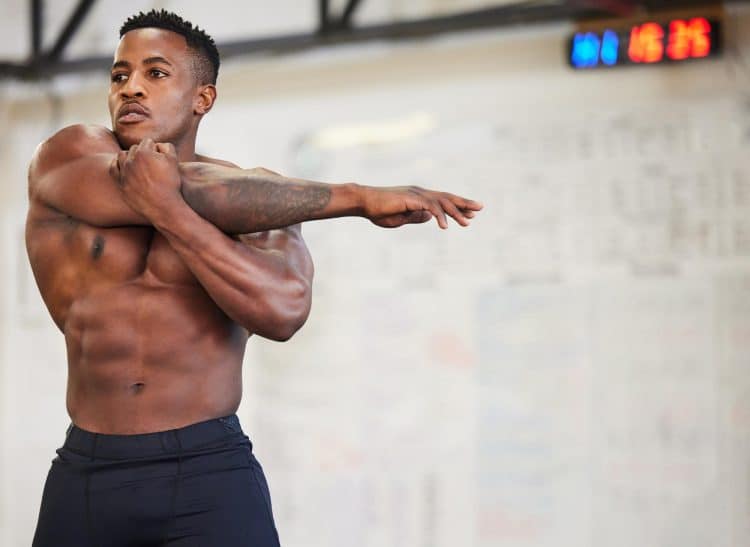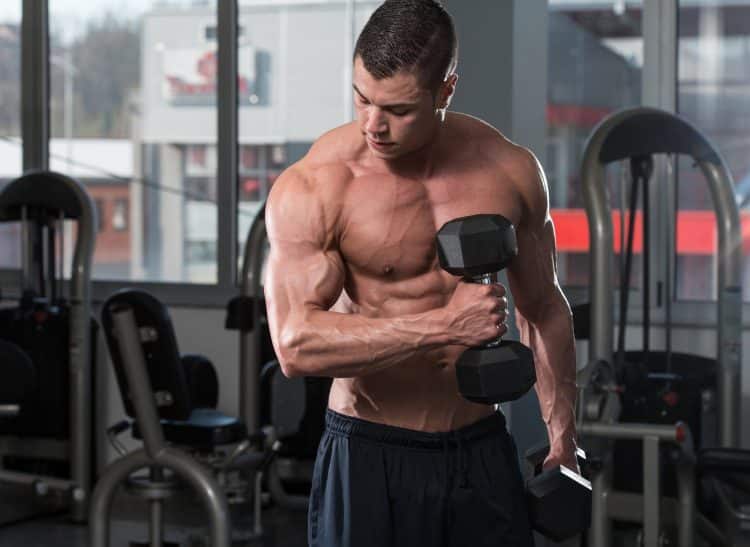I’ve been lifting weights since I was about 16. That’s nearly 40 years! Over that time, I’ve been a bodybuilder and powerlifter and trained to improve my performance in various sports, from running to rock climbing to rugby. I’ve also been a personal trainer, gym owner, and personal training certification course lecturer. Now I write about fitness full-time.
Nowadays, I lift weights for the health benefits and because I don’t want to be a weak old man. Plus, I’m kind of vain, so I like being leaner and more muscular than the average guy my age.
I’ve learned a lot about training over those four decades – both in theory and practice. I’m also a bit of a geek and love nothing more than topping up my knowledge with the latest training research and findings, which I then share through my articles and books.
Long story short, I know my stuff!
Over the years, I’ve seen a lot of rookie bodybuilders make the same mistakes over and over again, sabotaging their progress. Heck, I’ve BEEN that rookie and made some of those mistakes myself!
Time and energy are precious commodities, and I hate to see them wasted. However, despite being so widespread, newbie bodybuilders keep doing the same things wrong, and that must stop.
There are few things worse than seeing a novice bodybuilder hitting the weights but not getting the results they want. Not only is this a waste of energy and time, but it can lead to frustration and dissatisfaction. It may even make our beginner quit training altogether.
So, in this article, I’m going to share the 13 biggest, most common beginner bodybuilding mistakes. That way, you can avoid the biggest pitfalls and maximize your newbie gains.
1. Failing to Warm Up Properly
One of the best pieces of training advice I ever received was from my first phys. ed. teacher, who told me, “If you don’t have time to warm up, you don’t have time to work out.” He then went on to extol the virtues of warming up, such as lower risk of injury and improved performance.
Beginners often fail to understand how warming up can affect their workouts. A good warm-up prepares your muscles, joints, nervous system, and mind for what you are about to do. You’ll be able to train harder, longer, and more effectively when you’re warmed up.
A strength training warm-up should contain the following ingredients:
- Pulse Raiser – 5-10 minutes of light cardio to get your blood pumping.
- Dynamic Flexibility Exercises – to loosen your muscles and reduce the risk of injury.
- Joint Mobility Exercises – to increase range of motion and reduce wear and tear.
- Ramped/Rehearsal Sets – to optimize your neuromuscular system and increase strength and power.
Key Takeaway: Not warming up will save you a little time in the short term but could cost you months of progress because of unproductive training or avoidable injuries. Long story short – never skip your warm-ups!
2. Lack of a Clear Program
When I was in the Marines, we had a saying: failing to plan means planning to fail. As such, every operation started with a lengthy planning session, so every member of the team understood the mission and their role in it.
Having a plan increases your chances of successfully achieving your objective. That’s true in combat, business, medicine, and just about every other aspect of life. And yet, many beginners walk into the gym without a well-defined workout plan. They flit and flutter from one exercise to the next with no clear purpose.
Unfortunately, such an approach is seldom successful. This is because of the specificity principle, which says your body adapts to the training you do. So, if you have a specific goal, such as bodybuilding, you should follow a program that addresses that goal.
While just about everybody who lifts weights should eventually graduate to writing their own training programs, there are plenty of off-the-peg workout plans available for beginners.
These programs focus on the basics and build the foundation for your hopefully long and productive training career.
So, don’t set foot into the gym until you have a plan. Not having a plan is like going on a long journey without a map; you may reach your destination, but if you do, it’ll be blind luck and probably take you much longer than it could or should have.
Key Takeaway: Follow an appropriate training program for optimal gains.
3. Program Hopping
Leading on from the point above, many beginners assume that it’s their program that drives their gains. As such, they are always on the lookout for the next, best program that will help them build muscle faster. It’s like they think there is a secret workout they need to discover, and once they find it, their place on the Olympia podium is all but guaranteed!
Subsequently, they change their workout every week, always seeking that elusive, perfect training plan.
Unfortunately, rather than accelerating your gains, hopping from program to program every few weeks will hinder your progress.
Your body will respond best to a consistent workout plan you follow for anywhere from 8-12 weeks. This will give you time to learn the exercises and to progress your training weights and reps, which are the true drivers of muscle growth.
Experienced bodybuilders often talk about the muscle confusion principle, where you change your workout often to avoid plateaus. While this can work, beginners don’t need to use this training system yet, as they haven’t spent long enough mastering the basics. In short, a straightforward program performed consistently is already enough of a novelty to trigger muscle growth.
Key Takeaway: Stop looking for the perfect program and work the one you are on. Train hard, be consistent, and change your workout when your gains start to stall.
4. Training Like the Pros
Imagine you are a newbie runner. Despite never having run before, you download GOAT Eliud Kipchoge’s current training plan and try to follow it. The first workout involves running 22 miles and another ten later the same day. This is your routine for the rest of the week – a long run every morning and a shorter one each evening, seven days a week.
Needless to say, such an intense, high-volume workout plan will crush you, and you won’t be able to stick with it.
While this might sound like a ludicrous scenario, it’s precisely what happens when a beginner tries to follow a program written for a pro or top amateur bodybuilder. Sadly, many of the workouts in bodybuilding magazines and on fitness websites are just as impractical for beginners.
Unfortunately, as far as many fitness media outlets are concerned, basic beginner programs are boring. Instead, everyone wants to read about crazy pro workouts, and beginners wrongly assume this is how they should train, too.
Studies suggest you only need a few intense sets a week to build muscle, and marathon workouts are unnecessary for the average trainee. Longer workouts may be useful for lifters with years of training experience. However, for beginners, pro training programs are too much too soon and likely to do more harm than good.
Key Takeaway: You are not a pro bodybuilder, so don’t try and train like one. Stick to programs designed for beginners. Overly advanced programs could hurt your long-term progress.
5. Failing to Master the Basics
As well as being attracted to programs designed by or for pro bodybuilders, beginners are often drawn toward advanced-level exercises. They assume these moves are better for building muscle than the basics, so they include them in their workouts.
This is a mistake!
There is no point in doing things like power cleans, push presses, butterfly pull-ups, archer push-ups, guillotine presses, spider curls, etc., if you are yet to master the fundamentals.
Doing advanced exercises as a beginner is like trying to walk a tightrope when you are still learning to crawl. You haven’t developed the foundation you need to do the more demanding movements correctly, so they won’t be effective and may even be dangerous.
So, before you rush off to try the latest “functional” bodybuilding exercises, even if they promise incredible muscle growth, spend at least a couple of years focusing primarily on building technical proficiency and strength in the basics.
These exercises include:
Between them, this list of exercises contains everything you need to create the best training plan for beginners. There are fancier, more complex exercises you can use, but in most cases, these moves provide the biggest bang for your training buck.
Key Takeaway: Complex exercises do not produce better results than the basics. Build your beginner workouts around exercises like squats, bench presses, and pull-ups, saving the more exotic movements for when you need them.
6. Using Poor Form
There are two ways to do any exercise – the right way and the wrong way. The right way puts the tension on the muscles you want to work while steering it away from those you don’t. It’s also easier on your joints and keeps the risk of injury as low as possible.
In contrast, the wrong way often takes tension away from the area you want to develop and puts it on nearby muscles and joints. In many cases, this also increases your risk of injury.
There are several reasons that beginners use poor form during their workouts:
- Lack of Knowledge – they don’t know there is a right way and a wrong way to work out and assume that form doesn’t matter.
- No Instruction – they’ve never been shown how to perform their exercises correctly.
- Never Been Injured – they’ve yet to learn from their mistakes or don’t appreciate the dangers of working out with poor form.
- Weights Are Too Heavy – they aren’t ready to lift such heavy weights and cannot stabilize and move them efficiently.
- Bad Advice – while “go heavy or go home” makes for a good meme or T-shirt slogan, you don’t actually need to lift huge weights to build muscle. In fact, contrary to popular belief, you can build muscle with light weights and high reps (2).
Key Takeaway: Your form is essential for minimizing your risk of injury and maximizing muscle-building gains. Learn how to perform the exercises in your program correctly. Only add weight when you are sure you have mastered your form. Seek guidance if you are unsure how to do an exercise correctly.
7. Ego Lifting
Get two bodybuilders together, and invariably, one will ask the other, “Bro – how much can you bench?” It’s this attitude that probably makes beginner bodybuilders think that more weight equals greater gains.
While the amount of weight you lift is important, it’s not the only thing that determines your progress. Other factors include:
- Reps
- Number of sets
- Proximity to failure
- Weekly training volume
- Training frequency
- Recovery between sets and workouts
- Nutrition
- Sleep
- Genetics
Mindlessly adding more weight to the bar is not the only or the best way to build muscle. That’s especially true if that extra weight causes your form to break down. So, while you should endeavor to lift more weight as you get stronger, this should be a gradual and natural process and doesn’t need to be forced.
If you are motivated by lifting heavy weights, consider making the switch to Olympic weightlifting or powerlifting. For bodybuilders, the weight is just a tool and should not be driven by your ego. In many cases, a lower weight lifted well will do more good than a heavy weight lifted badly.
Key Takeaway: Your muscles don’t know how much weight you are lifting. You can build mass with light, moderate, and heavy loads. So, don’t get hung up on your training weights. Instead, look for ways to make those weights as impactful as possible. Heavier loads are not always better.
8. Chasing DOMS
Intense bodybuilding workouts often result in delayed onset muscle soreness, or DOMS for short. This is an indicator that you have pushed your muscles harder than usual. However, while DOMS is common, it is NOT a reliable indicator of muscle growth or an effective workout. In fact, if severe, it could suggest you have trained too hard or too long.
Some beginners chase DOMS like it’s the holy grail of muscle growth. They wrongly assume that the more they hurt, the greater their gains will be. No pain, no gain, right?
This really isn’t true. While there is no reason to fear DOMS, there is no need to pursue it, either. More DOMS does not equal more muscle growth. In fact, if you are so sore that you cannot work out as planned, it’s safe to say it’s detrimental to your progress.
Key Takeaway: While some delayed onset muscle soreness or DOMS is inevitable, it doesn’t mean your workout has been especially productive. So, don’t chase DOMS, and understand that severe muscle soreness is detrimental to your progress.
9. Overtraining/Under Recovering
Overtraining is usually the result of training longer and harder than you can recover. Beginners often fall into the “more is better” trap and do workouts that are beyond their current recovery abilities. They may also be heroes in the gym but fail to pay enough attention to their diets and sleep, essentially taking more out of their bodies than they put back in.
While feeling tired after a workout is normal, something is wrong if you feel chronically fatigued. Overtraining is not a badge of bodybuilding honor. In fact, it will slam the brakes on your progress and could even lead to regression.
Common symptoms of overtraining include:
- Decreased libido
- Decreased training motivation
- Decreased workout performance
- Elevated resting heart rate
- Hormonal imbalance
- Increased susceptibility to infections
- Insomnia
- Irritability
- Loss of appetite
- Menstrual cycle irregularities
- Mental fog
- Muscle soreness
- Persistent fatigue
- Plateau or decline in strength gains
- Reduced immune function
Key Takeaway: If you experience more than a few of these symptoms, you may be overtrained. Take a few days off, reduce your training intensity and volume, and make sure you are paying attention to rest, recovery, and diet.
10. Poor Nutrition
Intense bodybuilding training takes a lot out of your body, using energy and damaging your muscles at a microscopic level. While this may sound unpleasant, it’s actually the trigger for muscle hypertrophy, and your muscles grow back bigger and stronger as a result.
However, for these adaptations to occur, your body needs certain resources, which it gets from your diet. A good bodybuilding diet should contain:
- Sufficient calories to fuel your workouts and muscle growth
- Adequate protein – typically one gram per pound of body weight.
- Carbohydrates for energy
- Healthy fats for hormonal regulation
- Vitamins and minerals for optimal health and cellular function
- Fiber for digestive system health
- Plenty of water to prevent dehydration
Needless to say, it’s hard to achieve these standards if you aren’t paying attention to what and how much you eat. Bodybuilding is often said to be 50% training and 50% nutrition. While the exact split is debatable, it’s safe to say that at least some of your progress depends on your diet, and ignoring the nutritional aspect of bodybuilding can negate the hard work put in at the gym.
Key Takeaway: It’s often said that you are what you eat, and that’s especially true for bodybuilding. Make sure your diet provides the energy and nutrients you need to train hard and recover from your workouts.
11. Focusing Too Much on Supplements
Supplements are (or can be) a big part of bodybuilding. According to many sources, including magazines, fitness influencers, and sponsored bodybuilders, you can’t build muscle without various pills, potions, and powders.
However, this is not strictly true. In fact, people have been building massive muscles without supplements for hundreds of years, and you can do it, too.
While some supplements can be helpful, such as creatine and protein powder, they won’t help you if your training or diet isn’t right or you aren’t getting enough sleep. Supplements are the “icing on the cake,” but many novice bodybuilders fall into the trap of thinking they’re essential.
Misleading advertising, infomercial articles, false claims, and other dirty tricks can make supplements sound more potent than they really are. Remember, too, that supplement manufacturers often pay celebrities to say nice things about their products, and you’ll have to search hard for impartial supplement reviews.
Supplement politics and ethics aside, it’s essential to understand that your use of supplements will not make or break your bodybuilding progress. While they may offer a slight edge, you can build muscle without them.
Key Takeaway: Don’t believe the hype! While some supplements can be beneficial, even the bets only provide a slight advantage. There is no need to spend a fortune each month on supplements. Real food, adequate rest and recovery, and a sensible training plan are the cornerstones of effective bodybuilding.
12. Inadequate Sleep
“I’ll sleep when I’m dead” might sound like a cool way to live your life, but such an attitude could severely undermine your bodybuilding progress. Sleep is when your body gets busy rebuilding the muscle tissue damaged during your workouts. To facilitate this, levels of human growth hormone, testosterone, and other anabolic hormones increase while you dream of bigger biceps.
Not getting enough sleep will rob you of the energy you need to train at full intensity while undermining muscle growth. Talk about a double whammy!
Most bodybuilders should aim to get 7-9 hours of sleep per night. That’s not just weekends, but every night of the week. Invariably, this means going to bed a little earlier, as it’s often impractical to get up later, even if it is in the name of bigger muscles.
Key Takeaway: Lack of proper sleep can affect recovery and performance in the gym. It can also undermine muscle growth. Go to bed earlier to ensure you get 7-9 hours of sleep every night.
13. Training Through Injuries
A lot of experienced bodybuilders wear their injuries like a badge of honor. It’s as if they’re saying, “Yeah, I trained so hard I hurt myself, aren’t I dedicated?” However, while a few aches and pains are not much of an issue when you are young, as your 40s turn into your 50s and beyond, those minor niggles have a tendency to become major aches and pains.
Take it from one who knows: painful shoulders and knees are no fun when they stop you from doing the things you love. Ignoring minor injuries can lead to significant physical issues in the future.
Bodybuilding should be a lifelong pursuit, not something you do for a few years and then cast aside. It’s one of the most effective ways to avoid age-related muscle atrophy. In short, bodybuilding keeps you looking and feeling young.
So, don’t turn what should be a healthful pursuit into something that does you irreparable harm. Don’t ignore injuries, and don’t train through them so they worsen and never heal. Note this is different from training around an injury, where you find safe ways to keep working out that don’t aggravate whatever is ailing you.
Key Takeaway: Ignoring minor injuries can lead to more serious health issues in the long run. Don’t let niggles develop into severe injuries that could threaten your long-term bodybuilding progress. A week off now is preferable to a couple of months off later to allow a more serious injury to heal.
FAQ’s
Do you have questions about beginner bodybuilding, common mistakes, or training in general? No worries, because we’ve got the answers!
1. What’s the best way to warm up before a strength training session?
Warming up is a critical part of working out and helps prepare your mind and body for what you are about to do. Not warming up increases your risk of injury and could make your workout less effective.
The general consensus is that a strength training warm-up should comprise the following elements:
- Pulse Raiser – 5-10 minutes of light cardio to get your heart and blood pumping. This is the part of the warm-up that makes you warm.
- Mobility Exercises – to increase the production of lubricating synovial fluid. Example exercises include shoulder rolls and shrugs, shallow progressing to deeper knee bends, and ankle and writs circles.
- Dynamic Flexibility Exercises – to increase muscle elasticity. Examples include forward leg swings, waist twists, butt kickers, and alternating overhead reaches.
- Ramped/Practice Sets – a few sets of your first exercise per muscle group to fine-tune your technique and get your muscles working efficiently and in a coordinated way.
The colder you feel, the older you are, and the harder your planned workout, the longer your warm-up should be. However, avoid spending more time on your warm-up than necessary. Save your energy for training.
2. What are some common mistakes beginners make regarding exercise form?
Mistakes can vary from exercise to exercise, as each one provides an opportunity to do a whole lot of things incorrectly. That said, some errors that apply to multiple exercises include:
- Using momentum to lift the weight
- Not controlling the eccentric/lowering phase
- Using your legs or back to help raise a weight that’s too heavy for you
- Holding your breath
- Using too much weight
- Not bracing your core
- Not setting your shoulders back and down
- Moving too fast
- Using the wrong grip or stance
- Rounding your lower back
Many of these mistakes can be eliminated by using an appropriate weight, making sure you move smoothly and without momentum, and focusing on your mind-muscle connection.
3. What should I do if I experience persistent muscle soreness after workouts?
Muscle soreness is normal, especially for beginners. Any workout comes as a big shock to your system, so soreness is almost inevitable. You can minimize muscle soreness by always warming up properly, not training too hard or too long, and cooling down after your workout with a few minutes of light cardio followed by static stretches for the muscles you’ve just trained.
As you become accustomed to your workout, you should find that muscle soreness becomes less of an issue.
That said, if soreness persists, it could indicate that you are trying to do more than your body can cope with or recover from. In this case, you should dial back workout volume and intensity and then build back up gradually over the coming weeks and months.
Your persistent soreness may also be due to poor nutrition, especially too little protein or carbohydrates.
Do not resort to anti-inflammatory or pain-relieving medications to alleviate DOMS. These do nothing for the cause of your discomfort and only mask the symptoms.
4. How can I safely train around minor injuries without making them worse?
The best way to train around an injury is to avoid using the affected limb or muscle group. For example, if you have hurt your elbow, you’ll probably need to stop training your upper body for a while and focus on leg and core training.
Use your common sense and avoid doing anything that hurts the affected area, as that could just delay recovery. If you still have severe pain after a week or so, or the pain is severe, consult a medical professional, as you may need treatment.
5. What are some tips for staying consistent with my bodybuilding program?
We’ve written a guide on how to stay motivated and consistent – read it here. But the basic strategies you can use to maintain workout consistency are:
- Choose Activities You Enjoy: Opt for workouts that you find enjoyable to make your fitness journey sustainable and fun.
- Set a Schedule: Consistency is key; having a schedule helps you make exercise a regular part of your routine.
- Under-Commit, Over-Deliver: Start with manageable goals and exceed them when possible, building confidence and momentum.
- Embrace Simplicity: Keep your workout routine simple to avoid feeling overwhelmed, making it easier to stick to your plan.
- Have a Plan B: Always have an alternative workout plan for when life throws curveballs, ensuring you don’t skip exercise altogether.
- Get a Training Partner: A workout buddy can provide motivation, accountability, and even a bit of healthy competition.
- Never Miss Two Workouts in a Row: Missing one workout isn’t a big deal, but never allow yourself to miss two in a row to maintain consistency.
6. How long should a beginner stick to a basic workout program before considering more advanced exercises?
Even the best workout will lose its potency if you do it too often or for too long. If your progress is grinding to a halt despite training hard, eating well, and recovering like a boss, you may be due a new workout. Typically, this occurs every 8-12 weeks.
As you become more accustomed to working out and develop some experience, you can gradually start to introduce more advanced exercises and training methods into your training plan. Stick with bodybuilding long enough, and you may consider yourself advanced enough to try some really challenging exercises and workouts.
In terms of years, bodybuilders can be classified like this:
- Beginner Bodybuilder: 0-2 years
- Intermediate Bodybuilder: 2-5 years
- Advanced Bodybuilder: 5+ years
As you can see, advanced bodybuilders have at least five years of consistent training under their weightlifting belts. Up to that point, you probably won’t need many of the exotic training methods and exercises used by the pros.
7. What are some recommended resources for learning proper exercise form?
The best way to learn proper exercise form is with hands-on coaching from an experienced coach or trainer. Or, you could work out with a buddy who knows what they’re doing. If neither of these is possible, buy some books or use an online resource, such as YouTube or the Fitness Volt Exercise Database, where you’ll find detailed instructions for hundreds of exercises.
It’s also a good idea to video your form so you can see what you are really doing. Just because your technique looks okay in the mirror doesn’t mean it’s perfect. Video self-analysis is a very valuable tool for fixing form errors.
Got a burning question? Post it in the comments section, and we’ll get back to you ASAP!
Closing Thoughts
The era of information that we live in is a double-edged sword. No matter what you want to know, you can get answers instantly. While this means that newbies have tons of bodybuilding tips at their fingertips, that’s not always a good thing. Beginners can easily become sidetracked by flashy exercises and advanced workouts before mastering the basics, and that can slow you down or even get you hurt.
In addition, the internet is full of “experts” who talk a big game but don’t have the expertise to back it up. They know what they know because they’ve done an internet search and not because they’ve spent years training themselves and others, learning from experience. In fact, with the rise of AI, you might not be getting information from a human at all!
With all that in mind, beginner bodybuilders should start slow and simple, gradually making their workout harder and more complex as they gain experience. This is a process that takes years, not just a few weeks or months.
So, by all means, keep reading about advanced training methods and exercises, but enjoy them for what they are – entertainment. They’ll all be there when you are ready for them – in a few years’ time.
Meanwhile, train hard, eat well, get enough sleep, and let nature take its course. And above all, maximize your gains by avoiding the mistakes outlined in this article.
References:
- Androulakis-Korakakis P, Fisher JP, Steele J. The Minimum Effective Training Dose Required to Increase 1RM Strength in Resistance-Trained Men: A Systematic Review and Meta-Analysis. Sports Med. 2020 Apr;50(4):751-765. doi: 10.1007/s40279-019-01236-0. PMID: 31797219.
- Lasevicius T, Ugrinowitsch C, Schoenfeld BJ, Roschel H, Tavares LD, De Souza EO, Laurentino G, Tricoli V. Effects of different intensities of resistance training with equated volume load on muscle strength and hypertrophy. Eur J Sport Sci. 2018 Jul;18(6):772-780. doi: 10.1080/17461391.2018.1450898. Epub 2018 Mar 22. PMID: 29564973.
منبع: https://fitnessvolt.com/beginner-bodybuilding-mistakes/







